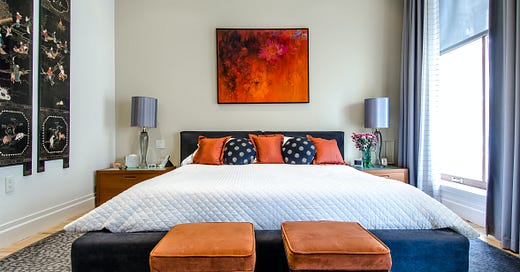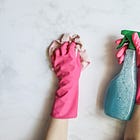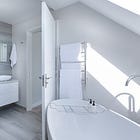39. Operational Insight: How to Deep Clean Bedrooms + Reception Rooms
Plus a workflow you can swipe
This week we’re diving into the cleaning bedrooms and reception rooms (lounge/dinner).
These rooms are easier to clean than the kitchen and bathroom because they don’t involve grease and limescale.
For a deep dive into the kitchen and bathroom deep cleaning workflows that our teams used, check out these posts:
Agenda
Products
Equipment
Prepare the clean
Start high, go low
Detailing
Clean out
Here’s the workflow:
Let’s break this down 👇🏾
Products
The product inventory for cleaning these rooms is simple:
Soap (washing up liquid) + Water
Glass Cleaner
If you think about the surfaces you’re cleaning - glass, wood, stone, metal - there’s no need for additional products.
When we started, we also used multi purpose cleaner and furniture polish. They added unnecessary inventory costs.
Soap, diluted in water is an effective multi-purpose at a fraction of the cost.
Clients expect clean surfaces, not polished surfaces, so we cut furniture polish from our inventory.
Equipment
Also simple:
Microfibre cloths (All surfaces)
Glass Microfibre (Glass + Mirrors)
Vacuum cleaner (Cupboards, drawers, floor)
Mop + Bucket (Hardwood or stone floor)
Steam Cleaner - optional (Mattress, Sofa, Armchair)
Prepare the clean
Same as the kitchen and bathroom, you need to clear the space before starting to clean.
You find the most interesting shit when clearing out a bedroom.
Apart from used condoms and tampons, some of the things we found included:
A VERY large dildo collection
Boxes of 80’s and 90’s video porn
An antique coin collection
Box fresh kicks
Unboxed iPhones and MacBooks
With valuables, we reported them back to the client or property manager. They might have unknowingly been left behind.
The last thing you want to do is risk your cleaning staff being accused of stealing.
After clearing the rubbish, our teams left the doors to these rooms open indicating that they were ready to clean.
Start high, go low
Especially important for bedrooms and reception rooms.
There are lots of high surfaces that gather dust because tenants rarely clean them.
These include wardrobes, cupboards, shelving, light fittings (lampshades, chandeliers) and curtain poles.
Next up are the windows, window frames, window ledges and vacuuming curtains & blinds.
Clean out the inside of cupboards, wardrobes, drawers, shelving and other storage units as well as sofas and armchairs.
To speed up this process, our teams used the vacuum cleaner with a brush extension. You mostly find dust inside cupboards etc. Any marks found after vacuuming were wiped down.
Wipe down any desks, tables, chairs, mirrors and the bed frame.
One request we received quite often was to steam clean mattresses, sofas and armchairs. It gets rid of smells, dirt and bacteria, which is important for landlords that are reluctant to buy a new furniture for every tenancy.
The service is a nice upsell that takes very little time to complete. It can increase your cleaning charge by 25/30% without additional labour costs.
To increase your charge by 50%+ - offer mattress and upholstery shampooing. You need a shampoo machine to offer this service - the same one used for cleaning carpets.
Worth either investing in one or outsourcing to a contractor because it can seriously increase the top line of each clean.
Finish up with wiping down skirting boards, radiators and plug sockets.
Detailing
Common areas that are often overlooked include:
Ceiling corners, light fittings, curtains and blinds - Popular spots for trapping dust and spider webs.
Wardrobe and cupboard tops - Easily forgotten and one of the first places an inventory clerk will check.
Behind + underneath furniture - Common areas for collecting dust and other rubbish. If the furniture can be moved safely + securely, move it and clean the unseen areas.
Behind and underneath beds - Also furniture, but a special shout out because there’s more shit that collects underneath beds than behind furniture. Clean it.
Flip mattresses - It surprising how much dust and other shit gets trapped underneath a mattress. Lose change, sweet wrappers and cotton buds are common items. Flip the mattress, vacuum both sides as well as the frame and you’re good to go.
Flip sofa and chair cushions - Food, pens, paperclips, remotes, a whole bunch of shit gets caught in between cushions. Make sure your remove them, vacuum the base and the cushions.
Clean out
Our teams always cleaned out of rooms, which meant starting at the furthest point in the room and cleaning towards the door.
As they cleaned out, all rubbish and unused cleaning products and equipment would be collected.
After the cleaning was finished and the floor was hoovered, our supervisor would check each room and make sure it was cleaned according to our checklist.
If the room had a hard floor it would be mopped before moving on to the next room.
With bedrooms and reception rooms in particular, once our team cleaned out, the doors would be closed signalling that the room was cleaned.
On to the next room.
Next week we’ll dive into hallways, landings and stairs, wrapping up this 4-part Operational Insight series for deep cleaning a residential property.
Got a question about deep cleans? Leave them in the comments below 👇🏾
Content to check out
Not subscribed to The Growth Lab podcast, bitesize tips and insights from the most successful cleaning business owners and entrepreneurs. Listen here.
Prefer watching over listening? Check out The Growth Lab podcast on YouTube.
Need More Help?
Email me with the growth strategy for your cleaning business. The more details you provide, the more personal I can make my response.
Want to build a £100K+ sales pipeline for your cleaning business in under 100 days? Book a call.
Thanks for reading!
Matt @ The Growth Lab
Forwarded this email?
Subscribe here:
Thanks for subscribing to The Growth Lab.







